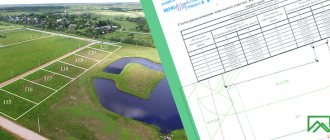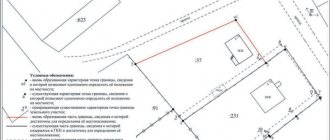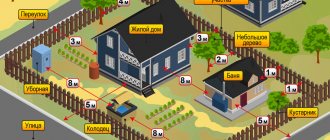Land ownership
In its most general form, property is the relationship of people to objects of the material world, manifested in economic and production relations between people in the process of production, distribution of exchange and consumption of various goods, as well as in legal norms and in the form of moral rules [1, p.21].
Under land ownership
understand the right of the owner of a land plot to take any actions in relation to it at his own discretion that do not contradict the law and other legal acts, do not violate the rights and legally protected interests of other persons and do not cause damage to the environment.
Despite the fact that land owners are constitutionally granted the right to independently own, use or dispose of them, there are still certain permanent or temporary restrictions.
In accordance with Art. 42 of the Land Code of the Russian Federation, permanent restrictions include the following responsibilities: preserve boundary, geodetic and other special signs located on the territory of the land plot and carry out measures to protect the lands belonging to it. Also, the rights of the owner limit the rights of the state to compulsorily purchase a land plot from the owner for state or municipal needs. Temporary restrictions include, for example, the owner’s obligation to use land plots in accordance with their intended purpose and belonging to a particular category of land and only in a permitted manner.
It is also necessary to distinguish between the concepts of subject and object of property.
(Table 1).
Table 1
Subjects and objects of property
| Subjects of land ownership – owners of specific land plots, vested with land rights and bearing responsibilities in accordance with land legislation. | Object of land ownership – in general, a piece of land as a spatial basis within certain boundaries of a fixed area and location. |
| Russian Federation and constituent entities of the Russian Federation represented by government bodies; cities, districts, settlements represented by local governments. | The entire land fund of the country (cadastral valuation, monitoring, etc.). |
| Citizens, associations of people, families, people, population, social group, including foreign citizens and stateless persons. | Land within a territorial administrative unit (provision, withdrawal of land, zoning, planning, etc.). |
| Legal entities - commercial and other organizations, including foreign ones, cannot be subjects of land legal relations; branches and representative offices of enterprises. | Separate land plot (in terms of use). |
| Unlike subjects, objects of land ownership are the passive side of property relations (a system of relations between people regarding the appropriation and alienation of land plots). | |
Land ownership includes three basic concepts (elements, powers): possession, use and disposal of a land plot
:
- ownership of a land plot is the primary component of ownership, physical control over the plot based on the law. It creates the necessary prerequisites for the implementation of two other powers - use and disposal. Ownership of a land plot is its possession as property (for a legal entity this is the ability to list it on its balance sheet);
- land use - the right to use not only the surface of the land plot and its soil cover, but also the mineral resources and water resources available on the land plot, that is, the opportunity to extract its beneficial properties; also, if this corresponds to the intended purpose of the plot, residential and industrial buildings can be built on it , cultural and other buildings and structures. That is, the use of a land plot is the use of a property in accordance with its purpose at the discretion and desire of the user and owner;
- disposal of a land plot is a comprehensive way of implementing the relationship between the object and the subject of ownership; the right to decide how and by whom the land plot can be used; the opportunity for the owner to determine the legal fate of his land.
The structure of land ownership is reflected
in table 2.
table 2
Land ownership structure
| Functions of property rights | ||
| Possession – actual possession of land by:
| Use – extraction of useful properties or income from the land in another way:
| Order – determining the legal fate of the site by:
|
| They can be concentrated with one owner or divided between different entities. | ||
All functions of land ownership are divided into general (the right to perform or not to perform certain actions in relation to the land) and special (determined by the intended purpose of the land plot, the peculiarities of the legal status of the owner or other circumstances).
In the Russian Federation, the right of ownership of land is protected by law, therefore the owner has the right to reclaim his land plot from someone else’s illegal possession, as well as demand the elimination of any violations of his property rights, even if they are not related to deprivation of possession of the land plot.
The Land Code of the Russian Federation provides for all the grounds for the emergence of land ownership rights. The Civil Code of the Russian Federation regulates the grounds for the emergence of land ownership and arises from the following documents: contracts, acts of a state body or local government, court decisions, and acquisitive prescription.
Type of ownership
– economic concept.
According to the definition of the Constitution of the Russian Federation (Article 9, Part 2), land and other natural resources can be in private, state, municipal
and other forms of ownership.
Private property - land plots acquired by citizens and legal entities of the Russian Federation on the grounds provided for by the legislation of the Russian Federation (clause 2 of article 15 of the Land Code of the Russian Federation) and by foreign citizens and legal entities and stateless persons (clause 5 of article 15, clause 5 of art. 28 of the Land Code of the Russian Federation). They are the owners of land plots acquired on the grounds provided for by law; have the right to equal access to the acquisition of land ownership; may receive ownership of state and municipal lands; owners of buildings and structures can privatize state land plots on which they are located (clause 1.9, article 36 of the Land Code of the Russian Federation), and foreign persons, subject to the restrictions established by law (clause 5 of article 15, clause 4 of article 28 of the Land Code RF); Land plots nationalized before January 1, 1991 are not subject to return, compensation or compensation (Article 25 of the Land Code of the Russian Federation).
There are two types of state ownership of land:
- Federal - state property of the Russian Federation as a whole - includes all land that is not directly transferred to private, municipal or the property of the subjects of the Federation. The purpose of which is to meet the needs of defense and security, border protection and other national functions. The rights of the owner are exercised by federal authorities, and in cases provided for by law - by legal entities. Ownership is not associated with mandatory use of land.
- Subjects of the Russian Federation - state property of republics, territories, regions, districts, autonomous regions and autonomous okrugs, cities of federal significance - within territorial boundaries, with the exception of lands transferred to federal, municipal, private and other forms of ownership. The purpose of which is to solve the problems of the subject of the Federation. Land management is carried out by state and local self-government bodies by issuing new legal acts. The subjects of ownership themselves do not carry out economic exploitation of the lands. The right of the owner coincides with the implementation of regulation and control over the use of all categories of land.
Municipal property is a territory within the boundaries of municipalities (cities, etc.) of various categories, the main purpose of which is to serve the needs of the local population, public utilities, engineering infrastructure, landscaping and for municipal organizations. The rights of the owner are exercised by local government and administration bodies and legal entities and individuals, in cases provided for by regulations.
So, the right of ownership of land is proclaimed by the Constitution of the Russian Federation, it is included in the fundamental rights and freedoms of man and citizen, which are inalienable, directly effective and cannot be changed except in the manner established by Art. 17, 18 and 64 of the Constitution of the Russian Federation.
Literature:
- Goremykin V.A. Modern land market in Russia: Practical guide. –M.: Publishing and trading corporation “Dashkov and K”, 2005. -624 p.
- Constitution of the Russian Federation. Anthem of the Russian Federation. – Novosibirsk: Sib. Univ. publishing house, 2009. – 32 p. – (Codes and laws of Russia).
- Land Code of the Russian Federation. – Novosibirsk: Sib. Univ. publishing house, 2009. – 112 p. – (Codes and laws of Russia).
- Short course on land law: textbook. allowance / G.S.Antosevich. – M.: Publishing house “Okey-book2”, 2008. – 123 p.
What is land division?
The division of land plots means a legally formalized procedure for obtaining several adjacent plots from one original one. Accordingly, these changes in boundaries and area are fixed in new documents (extracts from the Unified State Register), in cadastral data and on the ground. The result is several completely independent plots of land. That is, a new area is formed. But first things first.
Would you like to look at our work from a different angle?
Visit my Instagram - you won’t regret it!
Who carries out the division of land plots and what document prepares?
The division of a land plot into two or more parts is a special case of land surveying. And according to current legislation, land surveying can only be carried out by a cadastral engineer who has the appropriate permits. To make changes to the real estate cadastre, he prepares a boundary plan. Not to be confused with land management, cadastral plan, etc. About the differences - here. The main thing is that the cadastral engineer must prepare this document independently, starting with measurements on the ground and ending with the actual registration. Engaging uncertified employees is not permitted. This is by law. In fact, even in a large company there may be 1 real cadastral engineer who signs all the documents, and all the preparation is done by strangers. This is neither good nor very bad - the main thing is the correct result.
Why is it necessary to divide land plots?
So why do you need to divide the plot into two or more? The decision to divide a land plot arises for various reasons, here are the main ones:
- It is necessary to sell/donate/bequeath part of the original plot.
- It is necessary to allocate in kind the share of the land plot received through inheritance, donation, etc. That is, if the plot is in shared ownership, during division, each owner is allocated a part of the original plot, according to the shared participation. If the remaining shareholders do not want to divide the entire plot, they can allocate only their own share, and the rest of the plot will remain in shared ownership. Accordingly, if there are two owners, it can only be divided.
- When forming gardening partnerships, vegetable gardens and other non-profit land formations, it is necessary to divide the land plots between the owners.
- When spouses divorce or based on a court decision, the need to divide the plot also arises.
Improper use
Article 8.8. The Code of Administrative Offenses provides for administrative liability for the use of land plots other than for their intended purpose, failure to fulfill obligations to bring the land into a state suitable for use for its intended purpose.
The fine, depending on the category of land and the legal status of the violator, ranges from 10 to 200 thousand rubles.
Failure to fulfill construction obligations, if any had established deadlines, for legal entities can result in a fine of up to 700 thousand rubles, and negligence, which led to the fact that the land has become unsuitable for its intended purpose, is punishable by a fine of up to 50 thousand rubles for citizens, for legal entities – up to 400 thousand rubles.
You can read more about penalties for using land for other purposes here.
Buying land is a serious decision, mistakes in which can cost more than one thousand rubles and more than one lost day. Take seriously the collection of information about the site you are interested in, its category and permitted uses. If they do not meet your goals, seriously weigh your readiness for the hassle of transferring to the desired section, the possibility and expediency of this procedure.
The procedure for dividing land plots
There shouldn't be much difficulty here:
- collect the necessary documents⇑ and submit them to the cadastral engineer
- obtain a boundary plan for the division of the land plot (pay attention to the plan for dividing the land plot)
- submit it to the Rosreestr or MFC branch and receive new extracts from the Unified State Register of Real Estate for the formed areas.
After this we can say that the job is done.
Timing and results of land division
As mentioned above, there is a section with or without an engineer visiting the site. Accordingly, the time required to complete the work will vary.
- With departure - no more than 7 days. Several days are allocated for agreeing on the departure date and field measurements. At the same time, cadastral data is ordered. Towards the end of the allotted week, all the necessary data will be collected and the boundary plan will be ready.
- Without departure - several days, provided all documents and payment are available.
The result of the cadastral engineer’s work is a boundary plan on electronic media (CD-R disk). If you don’t want to go through government agencies with a boundary plan in hand, just leave it to us! More details in the agency services section.
As a result of the entire complex of work on dividing the land plot, the owner receives new extracts from the Unified State Register of Real Estate for plots within the new land use boundaries. Now you can dispose of the land as you wish. The plot within the general boundaries ceases to exist and is removed from the cadastral register.








